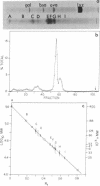Abstract
The receptor for acetylcholine was partially purified by affinity chromatography of an extract in Triton X-100 of membrane fragments from electric tissue. The receptor was assayed, after its reduction with dithiothreitol, by reaction with the affinity-alkylating agent, [methyl-3H]4-(N-maleimido)-benzyltrimethylammonium iodide. Alternative labeling procedures, one useful for routine assay of picomole quantities of receptor and the other for labeling larger quantities of receptor, are described. The purified receptor specifically incorporated about 3 nmol of label per mg of protein. This incorporation was blocked by pretreatment of the receptor with Naja naja siamensis neurotoxin. The rate of the affinity reaction was similar to that found with membrane fragments and with intact electroplax. Furthermore, as in intact electroplax, [3H]4-(N-maleimido)-benzyltrimethylammonium iodide reacted 5000-fold faster with the reduced receptor than did [14C]N-ethylmaleimide. When purified receptor was labeled with [3H]4-(N-maleimido)-benzyltrimethylammonium iodide and subjected to electrophoresis on polyacrylamide gels in dodecyl sulfate and dithiothreitol, three major protein bands were observed. Only one of these, however, contained 3H activity; its mobility indicated a molecular weight of 40,000.
Keywords: affinity chromatography, 4-(N-maleimido)-benzyltrimethylammonium, labeling kinetics, membrane proteins, subunit molecular weight
Full text
PDF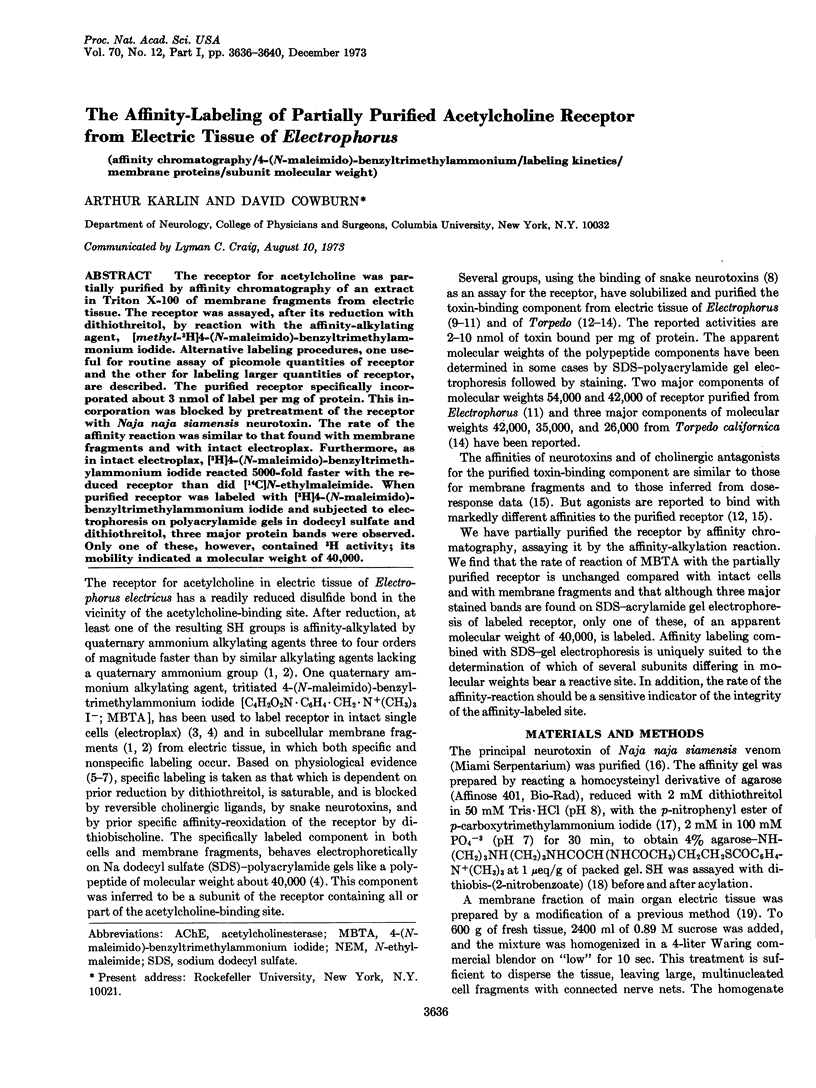

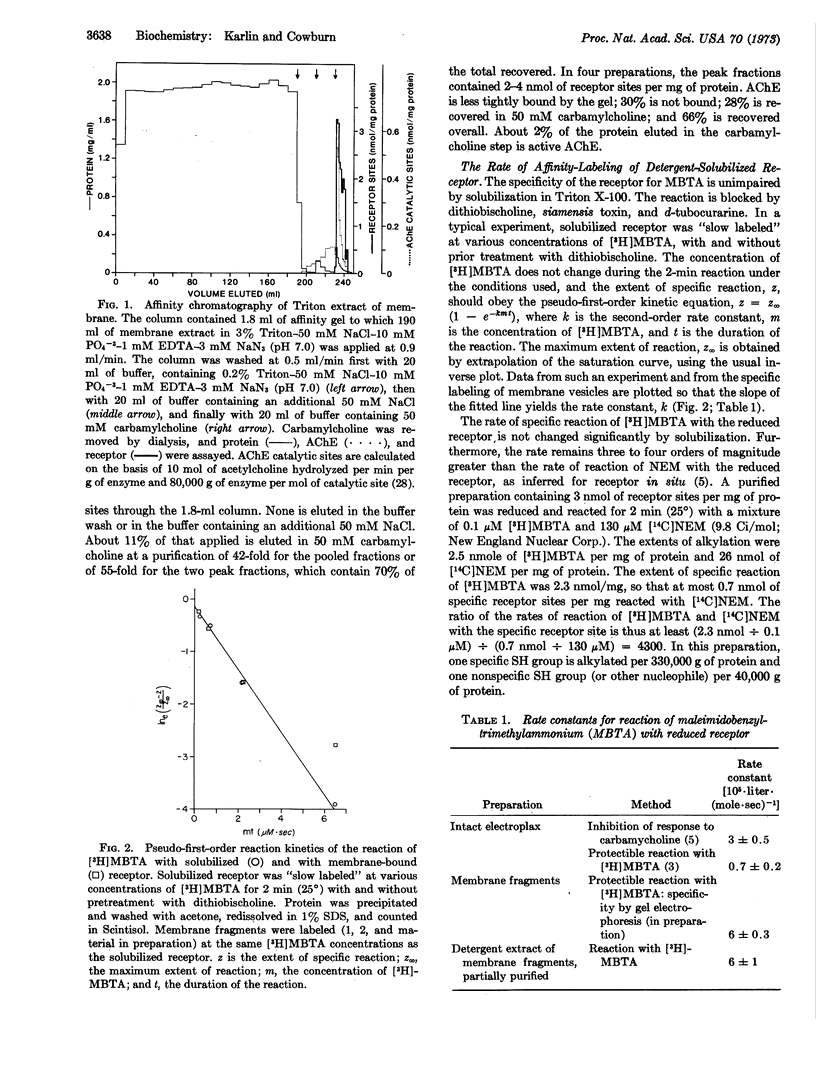
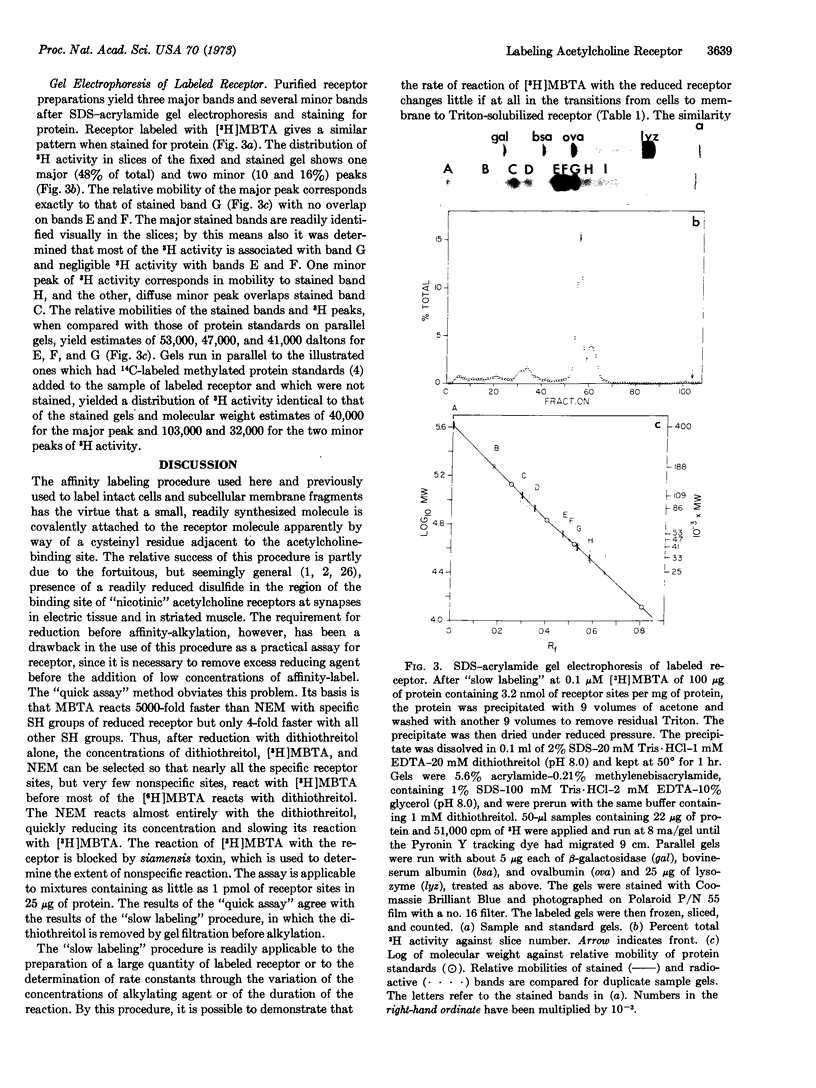
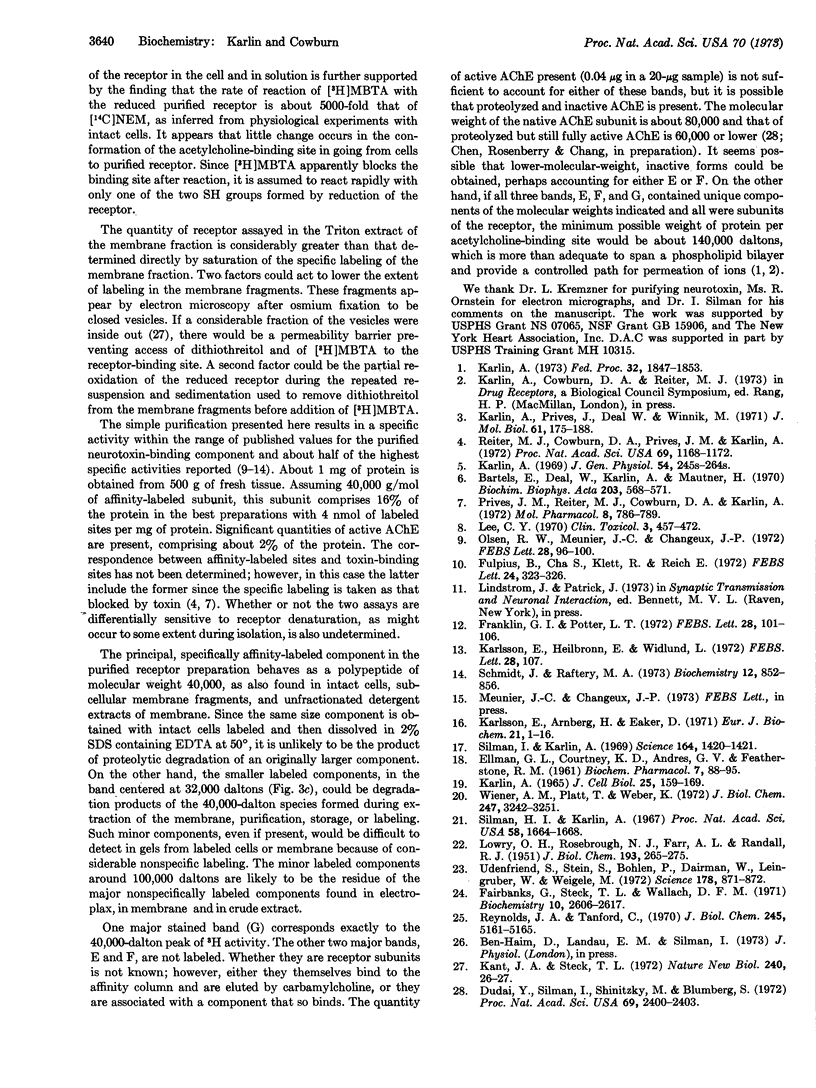
Images in this article
Selected References
These references are in PubMed. This may not be the complete list of references from this article.
- Bartels E., Deal W., Karlin A., Mautner H. G. Affinity oxidation of the reduced acetylcholine receptor. Biochim Biophys Acta. 1970 Jun 2;203(3):568–571. doi: 10.1016/0005-2736(70)90193-8. [DOI] [PubMed] [Google Scholar]
- Dudai Y., Silman I., Shinitzky M., Blumberg S. Purification by affinity chromatography of the molecular forms of acetylcholinesterase present in fresh electric-organ tissue of electric eel. Proc Natl Acad Sci U S A. 1972 Sep;69(9):2400–2403. doi: 10.1073/pnas.69.9.2400. [DOI] [PMC free article] [PubMed] [Google Scholar]
- ELLMAN G. L., COURTNEY K. D., ANDRES V., Jr, FEATHER-STONE R. M. A new and rapid colorimetric determination of acetylcholinesterase activity. Biochem Pharmacol. 1961 Jul;7:88–95. doi: 10.1016/0006-2952(61)90145-9. [DOI] [PubMed] [Google Scholar]
- Fairbanks G., Steck T. L., Wallach D. F. Electrophoretic analysis of the major polypeptides of the human erythrocyte membrane. Biochemistry. 1971 Jun 22;10(13):2606–2617. doi: 10.1021/bi00789a030. [DOI] [PubMed] [Google Scholar]
- Franklin G. I., Potter L. T. Studies of the binding of -bungarotoxin to membrane-bound and detergent-dispersed acetylcholine receptors from Torpedo electric tissue. FEBS Lett. 1972 Nov 15;28(1):101–106. doi: 10.1016/0014-5793(72)80687-2. [DOI] [PubMed] [Google Scholar]
- Fulpius B., Cha S., Klett R., Reich E. Properties of the nicotinic acetylcholine receptor macromolecule of Electrophorus electricus. FEBS Lett. 1972 Aug 15;24(3):323–326. doi: 10.1016/0014-5793(72)80382-x. [DOI] [PubMed] [Google Scholar]
- Kant J. A., Steck T. L. Cation-impermeable inside-out and right-side-out vesicles from human erythrocyte membranes. Nat New Biol. 1972 Nov 1;240(96):26–28. doi: 10.1038/newbio240026a0. [DOI] [PubMed] [Google Scholar]
- Karlin A. Molecular interactions of the acetylcholine receptor. Fed Proc. 1973 Aug;32(8):1847–1853. [PubMed] [Google Scholar]
- Karlin A., Prives J., Deal W., Winnik M. Affinity labeling of the acetylcholine receptor in the electroplax. J Mol Biol. 1971 Oct 14;61(1):175–188. doi: 10.1016/0022-2836(71)90214-2. [DOI] [PubMed] [Google Scholar]
- Karlsson E., Arnberg H., Eaker D. Isolation of the principal neurotoxins of two Naja naja subspecies. Eur J Biochem. 1971 Jul 15;21(1):1–16. doi: 10.1111/j.1432-1033.1971.tb01433.x. [DOI] [PubMed] [Google Scholar]
- Karlsson E., Heilbronn E., Widlund L. Isolation of the nicotinic acetylcholine receptor by biospecific chromatography on insolubilized Naja naja neurotoxin. FEBS Lett. 1972 Nov 15;28(1):107–111. doi: 10.1016/0014-5793(72)80688-4. [DOI] [PubMed] [Google Scholar]
- LOWRY O. H., ROSEBROUGH N. J., FARR A. L., RANDALL R. J. Protein measurement with the Folin phenol reagent. J Biol Chem. 1951 Nov;193(1):265–275. [PubMed] [Google Scholar]
- Lee C. Y. Elapid neurotoxins and their mode of action. Clin Toxicol. 1970 Sep;3(3):457–472. doi: 10.3109/15563657008990119. [DOI] [PubMed] [Google Scholar]
- Olsen R. W., Meunier J. C., Changeux J. P. Progress in the purification of the cholinergic receptor protein from Electrophorus electricus by affinity chromatography. FEBS Lett. 1972 Nov 15;28(1):96–100. doi: 10.1016/0014-5793(72)80686-0. [DOI] [PubMed] [Google Scholar]
- Prives J. M., Reiter M. J., Cowburn D. A., Karlin A. Interactions of a cobra neurotoxin and affinity labels of the acetylcholine receptor in the electroplax. Mol Pharmacol. 1972 Nov;8(6):786–789. [PubMed] [Google Scholar]
- Reiter M. J., Cowburn D. A., Prives J. M., Karlin A. Affinity labeling of the acetylcholine receptor in the electroplax: electrophoretic separtion in sodium dodecyl sulfate. Proc Natl Acad Sci U S A. 1972 May;69(5):1168–1172. doi: 10.1073/pnas.69.5.1168. [DOI] [PMC free article] [PubMed] [Google Scholar]
- Reynolds J. A., Tanford C. The gross conformation of protein-sodium dodecyl sulfate complexes. J Biol Chem. 1970 Oct 10;245(19):5161–5165. [PubMed] [Google Scholar]
- Schmidt J., Raftery M. A. Purification of acetylcholine receptors from Torpedo californica electroplax by affinity chromatography. Biochemistry. 1973 Feb 27;12(5):852–856. doi: 10.1021/bi00729a011. [DOI] [PubMed] [Google Scholar]
- Silman H. I., Karlin A. Effect of local pH changes caused by substrate hydrolysis on the activity of membrane-bound acetylcholinesterase. Proc Natl Acad Sci U S A. 1967 Oct;58(4):1664–1668. doi: 10.1073/pnas.58.4.1664. [DOI] [PMC free article] [PubMed] [Google Scholar]
- Silman I., Karlin A. Acetylcholine receptor: covalent attachment of depolarizing groups at the active site. Science. 1969 Jun 20;164(3886):1420–1421. doi: 10.1126/science.164.3886.1420. [DOI] [PubMed] [Google Scholar]
- Udenfriend S., Stein S., Böhlen P., Dairman W., Leimgruber W., Weigele M. Fluorescamine: a reagent for assay of amino acids, peptides, proteins, and primary amines in the picomole range. Science. 1972 Nov 24;178(4063):871–872. doi: 10.1126/science.178.4063.871. [DOI] [PubMed] [Google Scholar]
- Weiner A. M., Platt T., Weber K. Amino-terminal sequence analysis of proteins purified on a nanomole scale by gel electrophoresis. J Biol Chem. 1972 May 25;247(10):3242–3251. [PubMed] [Google Scholar]



